当前位置:
X-MOL 学术
›
Water Res.
›
论文详情
Our official English website, www.x-mol.net, welcomes your
feedback! (Note: you will need to create a separate account there.)
Nitrifying niche differentiation in biofilms from full-scale chloraminated drinking water distribution system.
Water Research ( IF 11.4 ) Pub Date : 2020-03-22 , DOI: 10.1016/j.watres.2020.115738 Mercedes Cecilia Cruz 1 , Yissue Woo 1 , Hans-Curt Flemming 1 , Stefan Wuertz 2
Water Research ( IF 11.4 ) Pub Date : 2020-03-22 , DOI: 10.1016/j.watres.2020.115738 Mercedes Cecilia Cruz 1 , Yissue Woo 1 , Hans-Curt Flemming 1 , Stefan Wuertz 2
Affiliation

|
Tropical conditions favour the auto-decomposition of monochloramine (MCA) leading to disinfectant decay and free ammonia in drinking water distribution systems (DWDS); thus, they promote the growth of nitrifiers and the development of biofilms on the inner-pipe surface. Biofilms can adversely impact the provision of safe and biologically stable water. Moreover, there is a general lack of understanding of the role of microbial communities in DWDS in regions with warm temperatures and no distinct seasons. Here, we report a survey on biofilms from full-scale monochloraminated DWDS in a highly urbanised metropolis using next generation sequencing tools. The monitoring campaign consisted of sampling biofilms and bulk waters from 21 in-service pipes. We characterized the microbial community with emphasis on nitrifying bacteria and archaea using 16S rRNA gene amplicon sequencing and potential nitrification activity. Samples grouped into two clusters, characterized by their low (Cluster LD) and high (Cluster HD) α-diversity. Both clusters harbour microorganisms related to nitrification: i) Nitrosomonas (24.9-68.8%), an ammonia oxidising bacterium (AOB) that dominated Cluster LD, and ii) a co-aggregation of genus Nitrospira (9.8-32.5%), a nitrite oxidising bacterium (NOB), and Thaumarchaeota (1.4-10.9%), chemolithotrophic ammonia oxidising (AOA) archaea that were among the most abundant OTUs in Cluster HD. Activity tests performed with fresh biofilm samples confirmed that these two clusters represent distinctive biofilm niches performing different stages of the nitrification process. Cluster LD correlated with a high concentration of MCA, which caused dysbiosis and resulted in high unevenness of the cluster. In cluster HD, with more biomass, chemical reactions involving nitrite increased the MCA demand, releasing ammonia and allowing more nitrifiers to grow, like AOA and NOB. From this study, we conclude that an MCA residual gradient along the DWDS drives and shapes the microbial community assembly and should be considered when designing effective disinfection strategies.
中文翻译:

全面的氯化饮用水分配系统中生物膜的硝化利基分化。
热带条件有利于一氯胺(MCA)的自动分解,导致饮用水分配系统(DWDS)中消毒剂的分解和游离氨的释放;因此,它们促进硝化器的生长和内管表面生物膜的发展。生物膜可能会对安全和生物稳定的水的供应产生不利影响。此外,在温度不高,没有明显季节的地区,普遍缺乏对微生物群落在DWDS中作用的认识。在这里,我们报告了使用下一代测序工具对高度城市化大都市中的全程一氯化碳DWDS的生物膜进行的一项调查。监测活动包括从21条在役管道中取样生物膜和散装水。我们使用16S rRNA基因扩增子测序和潜在的硝化活性,重点研究了硝化细菌和古细菌的微生物群落。样本分为两个簇,其特征在于其低(Cluster LD)和高(Cluster HD)α多样性。这两个集群都包含与硝化有关的微生物:i)亚硝酸盐单胞菌(24.9-68.8%),一种主要控制集群LD的氨氧化细菌(AOB),以及ii)亚硝酸盐菌属(Nitrospira)的共聚集体(9.8-32.5%),亚硝酸盐被氧化细菌(NOB)和Thaumarchaeota(1.4-10.9%),化学营养型氨氧化(AOA)古细菌,它们是Cluster HD中最丰富的OTU之一。用新鲜的生物膜样品进行的活性测试证实,这两个簇代表了执行硝化过程不同阶段的独特生物膜壁ni。集群LD与MCA的高浓度有关,MCA浓度高导致营养不良并导致集群的高度不均匀。在集群HD中,生物量更多,涉及亚硝酸盐的化学反应增加了MCA需求,释放了氨并允许更多的硝化剂生长,如AOA和NOB。从这项研究中,我们得出结论,沿DWDS的MCA残留梯度会驱动和塑造微生物群落的组装,在设计有效的消毒策略时应予以考虑。
更新日期:2020-03-22
中文翻译:

全面的氯化饮用水分配系统中生物膜的硝化利基分化。
热带条件有利于一氯胺(MCA)的自动分解,导致饮用水分配系统(DWDS)中消毒剂的分解和游离氨的释放;因此,它们促进硝化器的生长和内管表面生物膜的发展。生物膜可能会对安全和生物稳定的水的供应产生不利影响。此外,在温度不高,没有明显季节的地区,普遍缺乏对微生物群落在DWDS中作用的认识。在这里,我们报告了使用下一代测序工具对高度城市化大都市中的全程一氯化碳DWDS的生物膜进行的一项调查。监测活动包括从21条在役管道中取样生物膜和散装水。我们使用16S rRNA基因扩增子测序和潜在的硝化活性,重点研究了硝化细菌和古细菌的微生物群落。样本分为两个簇,其特征在于其低(Cluster LD)和高(Cluster HD)α多样性。这两个集群都包含与硝化有关的微生物:i)亚硝酸盐单胞菌(24.9-68.8%),一种主要控制集群LD的氨氧化细菌(AOB),以及ii)亚硝酸盐菌属(Nitrospira)的共聚集体(9.8-32.5%),亚硝酸盐被氧化细菌(NOB)和Thaumarchaeota(1.4-10.9%),化学营养型氨氧化(AOA)古细菌,它们是Cluster HD中最丰富的OTU之一。用新鲜的生物膜样品进行的活性测试证实,这两个簇代表了执行硝化过程不同阶段的独特生物膜壁ni。集群LD与MCA的高浓度有关,MCA浓度高导致营养不良并导致集群的高度不均匀。在集群HD中,生物量更多,涉及亚硝酸盐的化学反应增加了MCA需求,释放了氨并允许更多的硝化剂生长,如AOA和NOB。从这项研究中,我们得出结论,沿DWDS的MCA残留梯度会驱动和塑造微生物群落的组装,在设计有效的消毒策略时应予以考虑。











































 京公网安备 11010802027423号
京公网安备 11010802027423号